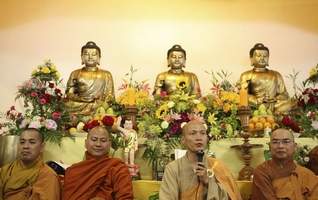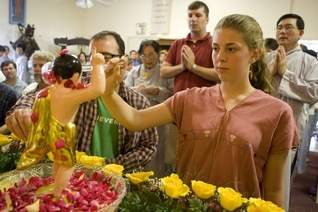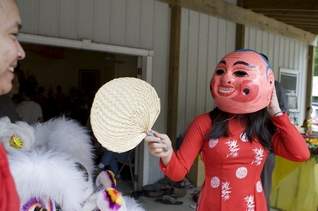May 31, 2009
As ceiling fans beat back the humid air, more than 150 people crowded in and around a temple on a remote Southern Indiana hillside last Sunday, marking the birth of their religion’s founder.
“An, de sa de sa tang gia ta ha,” they chanted, as worshipers lined up to ceremonially “bathe” a statue of a boy Buddha, ladling out water and flower petals from a bowl.
With golden Buddha shrines, prostrating monks in saffron robes, a traditional hillside temple location and picnic-style Vietnamese food, much of the scene could have been transplanted from predominantly Buddhist Vietnam.
But the afternoon-long ceremonies in Harrison County also reflected efforts to secure the tenuous future of American Buddhism, and they were heavy on youth involvement: Children sang and danced while teenagers mixed talk of Facebook and videos with traditional lion dances marking the religion’s holiest day.
Buddhism — personified by charismatic teachers such as Tibet’s Dalai Lama — has appealed to many spiritual seekers in recent decades and enjoyed Hollywood cachet.
But half of the adults who were raised Buddhist have left their childhood faith — more than almost any other religious category, according to a 2008 survey by the Pew Forum on Religion and Public Life.
Intermarriage, complex teachings, a Buddhist tolerance for other religions and the gravitational pull of a majority Christian culture all play roles in this, researchers and local Buddhists speculate.
One prominent Buddhist author, Clark Strand, of New York, says the problem is that spiritual seekers in the United States too often come to temples only for meditation lessons and don’t stay long.
‘Change or die’
American Buddhism “must change or die,” he said.
“There were a lot of people who felt the thing they liked about Buddhism was it’s not a religion and does not have rituals associated with it,” said Strand, a former Zen monk and senior editor of Tricycle, the magazine of record for American Buddhism.
He said that Buddhism could learn from Christianity and Judaism, given the powerful bond created through such rituals as baptisms, circumcisions, weddings and funerals.
“To hold on to the Buddhists they get … the Buddhist centers are going to have to solve this problem of birthing them, marrying them and burying them,” he said. “Those are the three transitional moments in human life that are generally managed by religion.”
Few for enlightenment
Buddhism originated with the teachings of Sakyamuni Buddha about 2,500 years ago in India and spread through much of eastern Asia. It grew significantly in the United States over the past few decades because of immigration from Asia and the popularity of Eastern meditation practices among American-born spiritual seekers.

A 2008 survey by Trinity College in Connecticut estimates that there are 1.2 million Buddhist adults in America — triple their number from 1990. The Pew Forum survey from the same year put it at 1.5 million — most of them American-born Caucasians and converts.
But the Pew Forum survey gives several hints of the challenges American Buddhism faces.
Buddhists, for example, are among the most likely to be in a religiously mixed marriage, and Buddhist parents are less likely than those of other religions to pray with their children or send them to religious-education programs.
And Buddhists are among the most tolerant of others’ religious choices — including their children’s.
For example, Vietnamese immigrants Hiep and Gam Ho, of Crestwood, said that when their sons were growing up in the 1980s, they brought them to a local Catholic church to learn about faith and ethics because there was no Buddhist temple nearby until they got older.
“Buddhist or Catholic, it doesn’t matter,” Hiep Ho said. They are now active at the local temple, but wherever they worship, what’s most important, he said, “is a big heart.”
Keeping the kids
Less than half a percent of Kentuckians and Hoosiers identify as Buddhist, according to the Pew Forum. But the religion’s diversity is on display in Kentuckiana, with local groups following traditions originating in Vietnam, Tibet and Japan.
Catherine McCliment of Louisville — who has been practicing Tibetan Buddhism since she studied in the 1970s at Indiana University under Thubten Norbu, the late brother of the Dalai Lama — said she’s not surprised many children raised in Buddhism don’t pursue the faith.
“Buddhism is complicated and deep,” said McCliment, 52. “In some ways, kids are not old enough to understand a lot of the black and whites and the grays in between.”
On the other hand, she said her 8-year-old daughter has often attended meditation sessions with her at the Drepung Gomang Institute in Louisville, sitting quietly and eagerly collecting the meditation cushions afterward.
And she has caught on to Buddhist ethics.
“Most kids can understand empathy and compassion, and really that’s the essence of it all,” she said. “They start to feel good about treating animals nicely, or not squashing a bug that you see immediately, or trying to help somebody who’s sick.”
Victoria Hamilton, of Louisville, grew up in a family practicing Soka Gokkai — a tradition that arose from Japanese Buddhism. She said she was in elementary school before she realized not every family had housefuls of guests chanting for world peace amid sandalwood incense.
She found out the hard way, she said — from former neighborhood friends who threw rocks at her when they learned she was Buddhist.
“It’s hard to stand out there alone and say, ‘Yep, I’m the only one,’ until you become secure in yourself,” she said.
But she began practicing her religion more intently in her teen years.
“You always grow up questioning, no matter what it is,” said Hamilton, 24. “But my parents always encouraged me (saying) ‘You can choose to practice or not but this is what we do.’ ”
Youthful hopes for faith

“They learn the teachings, plus we encourage them to do the practice at home too,” he said.
Advertisement
Sixteen-year-old Judy Do, of New Albany, Ind., said she enjoys “coming here and praying and learning new things about the Buddha and what to do and how to be kind to other people.”
She got a chance to exercise the basic Buddhist principle of compassion, she said, when she was visiting her parents’ native Vietnam a year ago and saw an emaciated old man.
“I decided to give him my food instead of eating it myself and give him my money instead of spending on me because I felt, ‘What if I was in that situation?’ ” she said.
Kevin Ho, of Crestwood, 19, said he doesn’t attend temple services weekly but tries to get there as often as possible — and enjoys taking part in dances and other traditions.
He said he feels the essence of Buddhism is “just being peaceful and treating others the way you want to be treated. I believe in karma. If you do something else, it comes back to you.”
By Peter Smith (psmith@courier-journal.com)
Source : Courier-Journal




